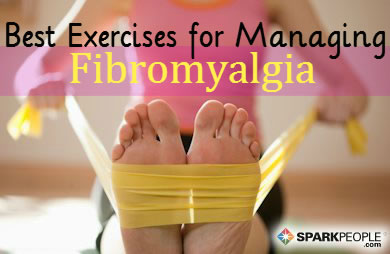Exercising with Fibromyalgia
The Best Exercises for People with Chronic Pain
SparkPeople advertisers help keep the site free! Learn more

| Fibromyalgia is a mysterious condition, characterized by long-term pain throughout the body. In many cases, it is accompanied by tenderness and swelling in the joints, muscles or other soft tissues (known as "tender points"). Fibromyalgia appears to affect the way the brain processes pain signals, lowering the threshold for pain and increasing sensitivity in people with the condition. While the exact cause of fibromyalgia is unknown, there are specific factors thought to trigger it. In some cases, symptoms begin after a physical or emotional trauma, infection or surgery. In other cases, symptoms build over time with no known cause. Fibromyalgia is most common in women between the ages of 20 and 50. In fact, 80% of people diagnosed with fibromyalgia are women. Fibromyalgia Symptoms Fibromyalgia is a syndrome—not a disease. A syndrome is defined as a group of signs and symptoms that together are indicative of a specific disease or disorder, but have no identifiable cause. Although the cause of the syndrome is unclear, the day-to-day effects for someone living with fibromyalgia can follow a very clear pattern. Flare-ups of symptoms come and go, more frequently for some people than others, and when they do, patients tend to wake up feeling stiff and sore. Some say the pain gets better as the day goes on but worsens at night. Others have pain throughout the entire day. Fibromyalgia pain can worsen with physical activity, changes in weather (cold and damp conditions are usually the worst) and stress. A 2007 survey published in the journal BMC Musculoskeletal Disorders asked more than 2,500 participants who had fibromyalgia about their ability to perform daily activities. According to the survey:
Exercise Can Be an Effective Treatment for Fibromyalgia Although strenuous physical activity can worsen fibromyalgia symptoms during flare-ups, exercise is often the first line of treatment to help reduce the frequency of flare-ups. However, sticking to a consistent exercise routine can be difficult because of fibromyalgia symptoms. Before starting any exercise program, it’s important to get clearance from your doctor and ask for their recommendations about what exercise is safe and what you should avoid. Continued › |
No comments:
Post a Comment